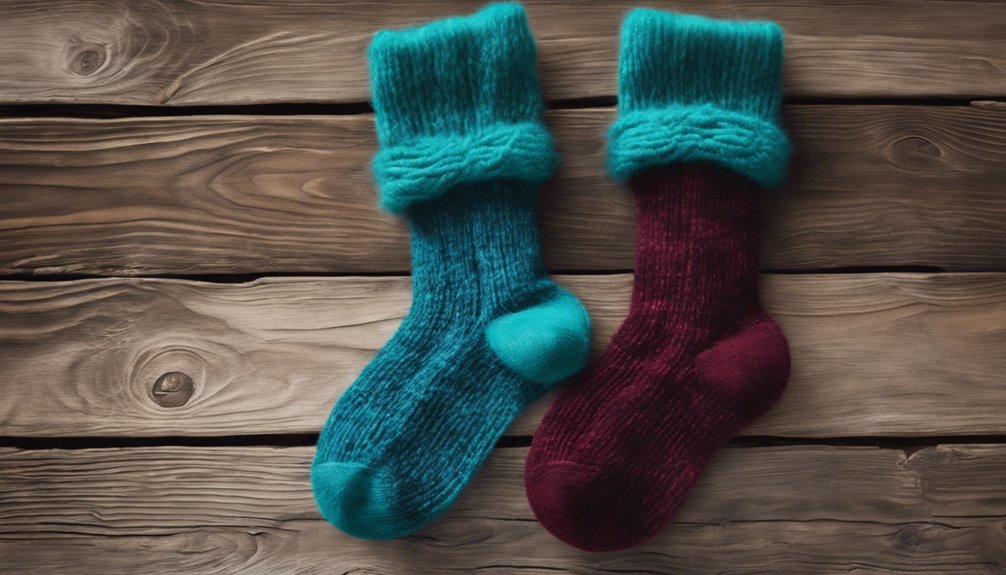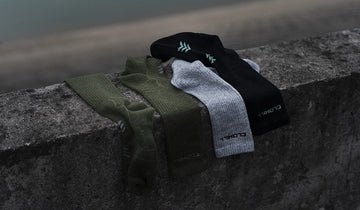Wool vs. Acrylic Socks: Which Is Best for Winter?
When it comes to winter socks, wool is generally the better choice for keeping your feet warm and dry. It excels at temperature regulation and moisture management, wicking sweat away while insulating against the cold. Although acrylic socks can be lightweight and affordable, they often lack the warmth and durability of wool. If you want to explore the unique benefits of each material further, you'll discover important factors that could influence your winter sock selection.
The Benefits of Wool Socks

While you might think all socks are created equal, the benefits of wool socks set them apart in several key ways. Wool excels in moisture management, effectively wicking sweat away from your feet. This keeps your skin dry and reduces the risk of blisters, allowing you to move freely without discomfort. Additionally, wool provides excellent temperature regulation. Whether it's cold or warm, wool adapts to your body's needs, ensuring your feet stay cozy without overheating. This adaptability makes wool socks a versatile choice for various activities, from hiking to everyday wear. By choosing wool, you're not just opting for comfort; you're embracing a sock that enhances your freedom to explore without the hindrance of moisture or temperature issues.
The Advantages of Acrylic Socks
Acrylic socks offer a range of advantages that make them an appealing choice for many. One notable benefit is their breathability features, which allow air circulation, keeping your feet comfortable during various activities. They're designed to wick moisture away, enhancing moisture management and preventing that damp feeling you might experience with other materials. This can be especially important if you're active or prone to sweating. Additionally, acrylic is lightweight, making these socks ideal for layering without adding bulk. Their vibrant colors and patterns also allow you to express your style freely. Plus, they're often more affordable than wool, making them accessible for everyone. When considering functionality and comfort, acrylic socks hold their own as a practical winter option.
Comparing Warmth and Insulation
When it comes to warmth and insulation, wool socks generally outshine their acrylic counterparts, particularly in colder climates. Wool's natural fibers provide superior heat retention, allowing your feet to stay warm even in frigid temperatures. It traps air pockets that act as insulators, creating a barrier against the cold. Additionally, wool excels at moisture management; it wicks away sweat while still retaining warmth, keeping your feet dry and comfortable. On the other hand, acrylic socks may feel warm initially, but they often lack the same level of insulation and can trap moisture, leading to cold, clammy feet. For true winter warriors seeking freedom from the chill, investing in quality wool socks can make all the difference in your comfort and overall experience.
Comfort and Fit: Wool vs. Acrylic

After considering warmth and insulation, comfort and fit become paramount when choosing between wool and acrylic socks. Wool generally excels in breathability factors, ensuring your feet stay dry and comfortable. It naturally manages moisture, drawing sweat away and reducing odor. On the other hand, acrylic socks offer a snug fit and quick-drying properties, making them a practical choice for active wearers.
- Wool provides natural cushioning for all-day comfort.
- Acrylic is lightweight and often less bulky.
- Wool's temperature regulation adapts to your body's needs.
- Acrylic's synthetic fibers resist shrinking and stretching.
Ultimately, the choice boils down to personal preference and specific activities. Whether you prioritize natural fibers or synthetic advantages, both options have unique benefits worth considering.
Cost and Durability Considerations
While both wool and acrylic socks have their respective price points, understanding the long-term value and durability of each material can greatly influence your purchase decision. In a cost comparison, wool tends to be pricier upfront but often lasts longer, making it a wise investment for those who prioritize quality. Acrylic, on the other hand, is generally more affordable, but its durability factors can be less impressive; you might find yourself replacing them more frequently. If you're seeking freedom and flexibility in your winter gear, consider how often you wear your socks and the environments they'll face. Ultimately, it's about balancing your budget with your need for longevity, ensuring you get the best value for your winter sock collection.
Frequently Asked Questions
Are Wool Socks Suitable for Individuals With Allergies?
You'd think wool socks are cozy for everyone, right? But if you've got wool allergens, they might trigger allergy symptoms. Consider hypoallergenic options to keep your feet warm without the sneezing or itching.
How Do Wool and Acrylic Socks Perform When Wet?
When wet, wool excels in moisture management, retaining warmth and drying relatively quickly. Acrylic socks, while faster to dry, can become cold and less effective at insulation, impacting comfort during your outdoor adventures.
Can I Machine Wash Wool Socks Without Damaging Them?
You'd think machine washing wool socks is a breeze, but it's not. Proper washing techniques, like cold water and gentle cycles, can enhance sock longevity, preventing damage while allowing you the freedom to enjoy them longer.
What Is the Best Way to Store Winter Socks?
To store winter socks effectively, consider using storage containers for sock organization. Keep them in a cool, dry place, and avoid overcrowding to maintain their shape and quality, ensuring they're always ready for use when needed.
Are There Eco-Friendly Options for Synthetic Acrylic Socks?
Yes, there're eco-friendly options for synthetic acrylic socks. You can find brands that utilize recycled materials and offer sustainable alternatives, reducing environmental impact while still providing comfort and functionality for your winter adventures.







